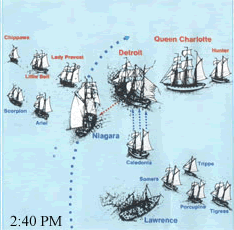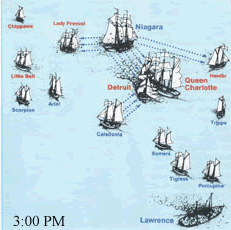
NPS Photo By 2:30 p.m. the flagship was a floating wreck; every gun on her engaged side was disabled and four of every five men fit for duty were either killed or wounded. Perry was facing the dismal prospect of surrender. 
NPS Photo The vessels anchored and hasty repairs were underway near West Sister Island when Perry composed his now famous message to William Henry Harrison. Scrawled in pencil on the back of an old envelope, Perry wrote, "Dear General: We have met the enemy and they are ours. Two ships, two brigs, one schooner and one sloop. Yours with great respect and esteem, O.H. Perry". The Battle of Lake Erie proved one of the most resounding triumphs of the War of 1812. The victory secured control of the lake, forcing the British to abandon Fort Malden and retreat up the Thames River. Harrison's army pursued, decisively defeating the small British army and its allied Indian force on October 5, 1813 at the Battle of the Thames. And later, during the peace talks, the dual victories of Lake Erie and the Thames insured that the states of Ohio and Michigan would remain the sovereign territory of the United States of America. page 1. page2. |
Last updated: April 10, 2015
